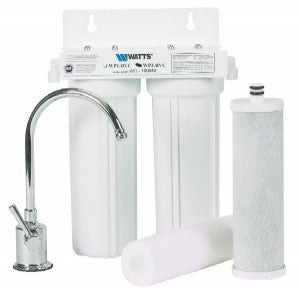What is the best drinking water system?
There is no "BEST" filter or system, but there are several questions you should ask yourself to determine which type of system is best for you. There are also some questions you should ask if someone is trying to sell you a water treatment system.

First of all you need to determine why you want a drinking water filtration system. Are you only concerned with aesthetics (taste, odor, etc.), or are you concerned with possible contaminants in the water, which you wish to reduce? These are two very different issues. For example, if you are only concerned with aesthetics, then simple carbon filter or counter-top faucet unit may suffice. A word of caution is in order here: Be sure to change the filters at the appropriate intervals recommended by the manufacturer. If carbon filters are not changed at proper intervals, it is possible for phenomenon called "dumping" to occur. In simple terms, this is when a substantial portion of contaminants filtered out (trapped) is released due to exhausting the capacity of the filter, creating a "chemical cocktail".
On the other hand, if you are concerned with potential dangerous chemicals in your water supply such as chlorine, THM's, PCB's, organic chemicals, pesticides, lead, bacteria, and other contaminants, then additional measures are required. These measures include prolonged-contact carbon filtration, ultra filtration, reverse osmosis, ultraviolet, ozone, and treatment with chemicals such as chlorine. Just remember: THERE IS NO INDIVIDUAL PROCESS THAT CAN SOLVE ALL WATER PROBLEMS! Each situation has to be assessed on a case-by-case basis, taking into consideration what the desired quality of the water needs to be, and the chemical analysis of the water to be treated.M
Carbon filtration is a marvelous method for removing chlorine, chemicals, pesticides and numerous other contaminants, providing it is applied properly. For example, you would not want to put a carbon filter on water that is microbiologically unsafe. This would require chlorination (with adequate contact time) ahead of the carbon filter, or some other method such as ultraviolet or ozonation to inactivate the bacteria. Some areas have experienced problems with cryptosporidium and/or girardia cysts (which are often resistant to chlorine). These little "devils" attack the gastrointestinal tract of individuals whose immune system has been compromised, and can cause death. In the early 1990's, thousands of people become sick and dozens died in Milwaukee as a result of cryptosporidium outbreak. There are special ceramic and other types of cartridges with an "absolute" rating of 1 micron or less, designed to remove these critters.
Other areas have high levels of total dissolved solids (TDS). TDS is the measure of sodium, chlorides, sulfates, carbonates, bicarbonates, calcium, magnesium, etc., in the water supply. At levels above the 500 mg/1 or ppm, it is desirable to reduce the TDS level. This can be accomplished with only three methods: deionization, distillation, and the most popular method: reverse osmosis (commonly called "RO"). Deionization and distillation are not as cost effective as reverse osmosis - thus the popularity of RO. Reverse osmosis is a method by which pressure is applied to a membrane, forcing the pure water through the membrane, with the impurities being flushed down the drain. RO is generally applied with other technologies, including micron filtration, carbon filtration and ultraviolet, producing exceptionally high quality drinking water.
Finally, when purchasing a system, you should be mindful of maintenance intervals and costs. Most systems need maintenance and filter changes at 6-12 month intervals. I would be highly suspicious of anyone who infers that longer intervals are adequate. THIS IS YOUR DRINKING WATER WE ARE TALKING ABOUT! Take nothing for granted and do your homework. A good system might cost a few hundred dollars, but unless you are treating a whole house or a large custom home, the system should not be expensive. It might cost a few hundred bucks, but be cautious about paying much more than that - you probably won't get a better system! Here are quality reverse osmosis systems that aren't overpriced, and you can contact the following organizations for further information: U.S. Environmental Protection Agency's Safe Drinking Water Hotline at (800) 426.4791, or check them out on the web at, www.epa.gov/ogwdw/wot/wot.html and Water Quality Association at (630) 505.0160, www.wqa.org






17 Comments
Hi, Sir, i have visited your site and found it very useful for me because i am also related to water treatment business. A question arises in dealing with customers that what is minimun and maximum TDS level acceptable for human being. And tell me that what is the best PH level for human being? I am trying to know this since for a long period.Tell me please the actual figure from reverse osmosis system, while we are getting water from the source of well. which shows 650 PPM level. At the end I would like to ask you that please tell me the maximum and mininmum TDS level which is the best and acceptable for human being. Thanks.
we live in golden valley az, recently we were inform about having a presence of coliform bacteria in our water.is ther any type of home water filtration system, that we can install for this problem
Leave a comment
Please note, comments need to be approved before they are published.